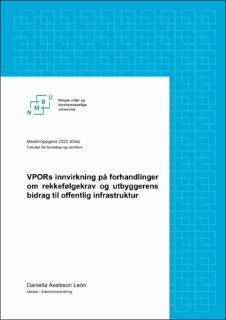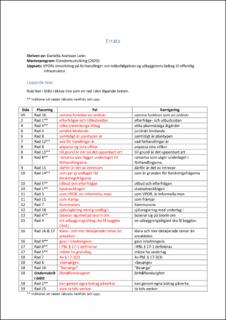| dc.contributor.advisor | Boge, Knut | |
| dc.contributor.author | Axelsson León, Daniella | |
| dc.coverage.spatial | Norway, Oslo | en_US |
| dc.date.accessioned | 2020-08-03T18:35:57Z | |
| dc.date.available | 2020-08-03T18:35:57Z | |
| dc.date.issued | 2020 | |
| dc.identifier.uri | https://hdl.handle.net/11250/2670697 | |
| dc.description | Publisert versjon er i henhold til Errataliste | en_US |
| dc.description.abstract | I utbyggningsprojekt är det alltid fråga om vad som ska byggas av offentlig infrastruktur (inklusive offentliga rum), och vem som har ansvaret för genomförandet och finansieringen av åtgärderna. Det generella antagandet är att utbyggaren önskar att betala så lite som möjligt, så sent som möjligt. Kommunen på sin sida önskar att utbyggaren tar samhällsansvar och finansierar de behoven som uppstår till följd av utbyggningsprojektet. VPOR är en icke-juridiskt bindande plan, som till skillnad från de juridiskt bindande kommunala planerna, innehåller en hög grad av detaljer kring den offentliga infrastrukturen som kommunen anser nödvändig att bygga i området. I tillägg innehåller VPOR en detaljerad kostnadsberäkning för utbyggarens bidrag.
Detta er en komparativ studie som undersöker förhandlingar om rekkefølgekrav och utbyggarens bidrag med utgångspunkt i två projektet i Oslo kommune. Ett projekt i ett område med Veiledende plan for det offentlige rom (VPOR), och ett projekt i ett område utan VPOR där endast de juridiskt bindande kommunala planerna gäller. Datainsamlingen för studien bestod av intervjuer med nyckelpersoner i projekten och dokumentanalys av både överordnade planer och projektspecifika dokument. Genom analysen och diskussionen, är det flera teman som har berörts med underlag i forskningsfrågorna för att svara på problemställningen. Dessa teman var: underliggande faktorer för förhandlingarna, förhandlingsteman, förhandlingsstrategier, medel för att påverka förhandlingarna, och utfall av förhandlingarna. Dessa lades sedan till grund för den vidare konklusionen om förhandlingar mellan kommun och utbyggare om rekkefølgekrav och utbyggarens bidrag.
Studien visar att VPOR, trots sin icke-juridiskt bindande status, ser ut till att användas av kommunen mer som en kontrollerande projektplan mot planförslaget, snarare än en strategisk plan för förhandlingar och beslut som berör utvecklingen. De huvudsakliga fynden visar att VPOR ger större förutsägbarhet för både kommunen och utbyggaren än de juridiskt bindande planerna, men lite förhandlingsutrymme för utbyggaren i förbindelse med rekkefølgekrav och bidrag som är viktiga faktorer för projektets ekonomi. VPOR kan därför ge kommunen en starkare position i förhandlingarna om de offentliga åtgärderna. I projekt med VPOR kan utnyttjandegraden för egendomen därmed bli ett viktigt förhandlingskort för utbyggaren som vill ha kompensation för att ha gett bort privat areal och/eller ekonomiskt bidrag till offentliga åtgärder. Detta kan resultera i mer distributiva förhandlingar. Utan VPOR verkar förhandlingsutrymmet om rekkefølgekrav vara större för bägge parterna, vilket främjar integrativa förhandlingar eftersom det finns utrymme för flera lösningar och parterna kan göra ”byten” baserade på olika prioriteringar, intressen, och behov. Utbyggaren kan även ha bättre styrning av sina kostnader beträffande offentliga åtgärder i områden utan VPOR. | en_US |
| dc.description.abstract | When developing a property or a larger area, there are always issues regarding public infrastructure (including public spaces) that need to be addressed by the municipality and the developer. What kind of public infrastructure does the area need, and who is going to build it and who is paying? The general assumption is that developer wishes to invest as little as possible in public projects, and pay for it as late as possible, while the municipality wishes for the developer to take responsibility and invest in the needs that originate as a result of the development project. VPOR is a highly detailed zoning plan for the public infrastructure and spaces within a specific area, which also includes detailed calculations of the anticipated costs. This zoning plan, however, is not part of the Planning and Building Act in Norway.
This is a comparative social science research study looking at the dynamics of negotiations between the municipality and developer regarding order provisions for public infrastructure and spaces, and the developer’s financial contribution. The study looked at two different projects in the municipality of Oslo, one within an area regulated by a VPOR-zoning plan, and another within an area regulated by the municipal master plan rooted in the Planning and Building Act. The data collection methods consisted of interviews and document analysis. The focus of the study is divided into five subjects: underlying factors and interests in the negotiations, issues discussed in the negotiations, negotiation strategy/strategies, power and tactics used in the negotiations, and outcome of the negotiations.
The study shows that despite VPOR not being part of the Planning and Building Act, the municipality seems to use VPOR as project plan aiming to control land use, and less as a strategic plan for decisionmaking. The main results show that VPOR provides the negotiators with higher predictability than the legally binding zoning plans. However, for the developer this implies less room for negotiation concerning order provisions as well as the amount of the financial contribution, which could have a big impact on the economy of the project. Thus, VPOR could give the municipality a stronger leverage in the negotiations. Consequently, in negotiations for projects within a VPOR-area the building density becomes a very important issue to the developer, who wishes compensation for the loss of building plot area and/or financial contribution going to public infrastructure and spaces. This could result in more distributive negotiations. In negotiations for projects in areas regulated by the ordinary legally binding zoning plans, the room for negotiation concerning order provisions (and the costs) seems to be bigger. This facilitates integrative negotiations as the parties can create a larger bargaining mix and thus also trade off issues/solutions based on different interests, needs and priorities. | en_US |
| dc.language.iso | swe | en_US |
| dc.publisher | Norwegian University of Life Sciences, Ås | en_US |
| dc.rights | Attribution-NoDerivatives 4.0 Internasjonal | * |
| dc.rights.uri | http://creativecommons.org/licenses/by-nd/4.0/deed.no | * |
| dc.subject | VPOR | en_US |
| dc.subject | Utbyggingsavtaler | en_US |
| dc.title | VPORs innvirkning på forhandlinger om rekkefølgekrav og utbyggerens bidrag til offentlig infrastruktur | en_US |
| dc.type | Master thesis | en_US |
| dc.description.version | publishedVersion | en_US |
| dc.subject.nsi | VDP::Social science: 200 | en_US |
| dc.source.pagenumber | 132 | en_US |
| dc.description.localcode | M-EUTV | en_US |


